
Detail of J. Stevens, A View of the Landing the New England Forces in ye Expedition against Cape Breton, printed by John Bowles, London. 14" x 19 1/4". Colored line engraving. This engraving shows a ship with carved ornaments of the type produced by Anthony and Brian Wilkinson. (Chipstone Foundation; photo, Gavin Ashworth.)

Anthony Wilkinson’s bill for ship carving for Thomas Penn’s barge, Philadelphia, August 28, 1734. (Courtesy, RAAB Collection)

Brian Wilkinson’s bill for carving for the ship Delaware, Philadelphia, April 25, 1762. (Courtesy, Ten Pound Island Book Company).

James Peller Malcolm, Christ Church, Philadelphia, 1814. 12 1/4" x 14 1/4". (Courtesy, Arader Galleries).

Truss on the steeple of Christ Church, attributed to the shop of Samuel Harding, Philadelphia, 1753.
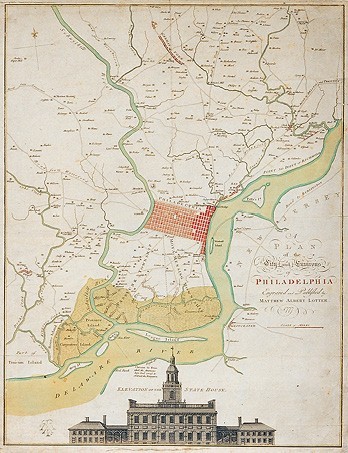
Elevation of the North façade of the Pennsylvania State House shown on Matther A. Lotter’s A PLAN of the City and Environs of PHILADELPHIA, Pennsylvania, 1777. (Courtesy, Winterthur Museum.)
Samuel Harding, bill for carving for the Pennsylvania State House done between January 29, 1775 and January 7, 1757. A transcription of this bill is in the research files, Independence National Historical Park. The citation on the transcription is shown above.

First floor, central hall in the Pennsylvania State House. (Courtesy, Historic American Buildings Survey, Library of Congress; photo, Jack E. Boucher, 1959).

Door pediment in the first floor, central hall in the Pennsylvania State House. (Courtesy, Historic American Buildings Survey, Library of Congress; photo, Jack E. Boucher, 1959).

Pediment and upper section of an architrave on the north wall of the first floor, central hall in the Pennsylvania State House. (Courtesy, Historic American Buildings Survey, Library of Congress; photo, Jack E. Boucher, 1959).

Keystone of a pedimented architrave in the first floor, central hall of the Pennsylvania State House. (Courtesy, Historic American Buildings Survey, Library of Congress; photo, Jack E. Boucher, 1959).

Frontal view of a truss on the steeple of Christ Church.

Indian head, door pediment in the first floor, central hall of the Pennsylvania State House. (Courtesy, Historic American Buildings Survey, Library of Congress; photo, Jack E. Boucher, 1959).

Brackets and balusters in the stair tower of the Pennsylvania State House. (Courtesy, Historic American Buildings Survey, Library of Congress; photo, Jack E. Boucher, 1959).

Frieze of a landing in the stair tower of the Pennsylvania State House. (Courtesy, Historic American Buildings Survey, Library of Congress; photo, Jack E. Boucher, 1959).

Venetian window and flanking pilasters and architraves in the stair tower of the Pennsylvania State House. (Courtesy, Historic American Buildings Survey, Library of Congress; photo, Jack E. Boucher, 1959).

Frieze applique on one of the pedimented architraves flanking the Venetian window of the stair tower of the Pennsylvania State House. (Courtesy, Historic American Buildings Survey, Library of Congress; photo, Jack E. Boucher, 1959).

Side view of an upper truss on one of the architraves in the stair tower of the Pennsylvania State House. (Courtesy, Historic American Buildings Survey, Library of Congress; photo, Jack E. Boucher, 1959).

Lower truss on one of the architraves in the stair tower of the Pennsylvania State House. (Courtesy, Historic American Buildings Survey, Library of Congress; photo, Jack E. Boucher, 1959).
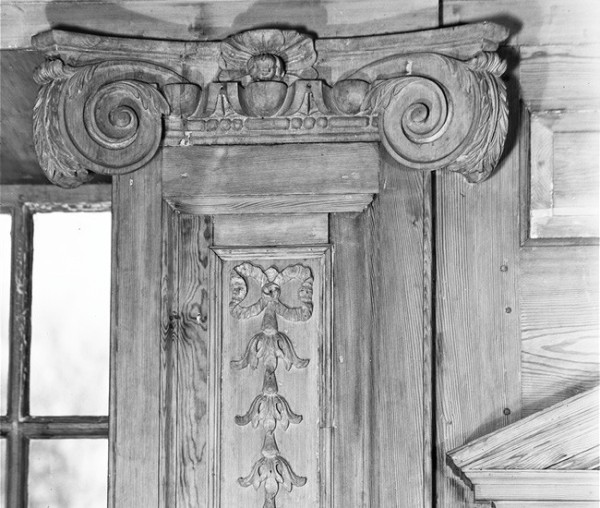
Pilaster capital and drops framing one of the architraves in the stair tower of the Pennsylvania State House. (Courtesy, Historic American Buildings Survey, Library of Congress; photo, Jack E. Boucher, 1959).

Exterior clock on the Pennsylvania State House.

Max Rosenthall, Interior View of Independence Hall, Philadelphia, 1856. (Courtesy the Library Company of Philadelphia.)

Frieze applique in the Assembly Room of the Pennsylvania State House attributed to the shop of Brian Wilkinson, Philadelphia, 1750–1755. (Courtesy, Historic American Buildings Survey, Library of Congress; photo, Jack E. Boucher, 1959).

Detail of the applique illustrated in fig. 23.

Detail of the applique illustrated in fig. 23.
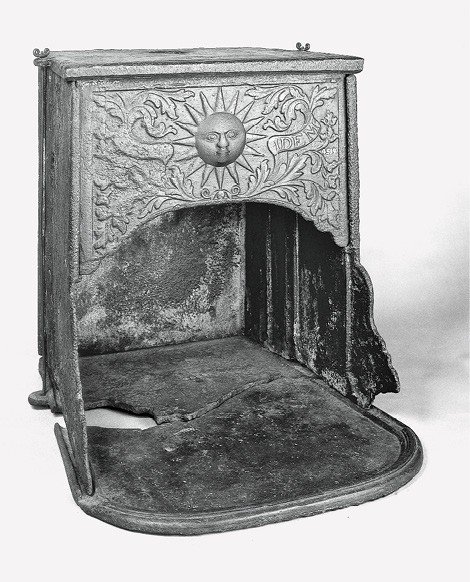
Franklin stove attributed to Warwick or Mount Pleasant Furnace, Chester or Berks County, Pennsylvania, c. 1742–1748. Cast iron. H. 31 1/2", W. 27 1/2", D. 35 3/4". (Courtesy, Mercer Museum of the Doylestown Historical Society; photo, Philadelphia Museum of Art.)

James Turner (w. 1744–1759) after Lewis Evans, design for Franklin’s Stove, illustrated in An Account of the New Invented Pennsylvanian Fire-places. (Courtesy, Library Company of Philadelphia.)

Detail of the front plate of the stove illustrated in fig. 26.

Tall case clock with movement by Peter Stretch and carving attributed to the Wilkinson shops, Philadelphia, 1735–1745. Mahogany with tulip poplar, and yellow pine. H. 110", W. 18 1/2", D. 9". Courtesy, Winterthur Museum: purchase with funds provided by the Henry Francis du Pont Collectors Circle, Winterthur Centenary Fund, Mrs. C. Lalor Burdick, Mr. and Mrs. Richard Chilton, Mrs. Robert N. Downs III, Mr. William K.
du Pont, Mr. and Mrs. Frederick C. Fiechter III, Mr. and Mrs. John A. Herdeg, the Hohmann Foundation, Family of Mr and Mrs. Walter M. Jeffords, Jr., Kaufman Americana Foundation, Mrs. George M. Kaufman, Mr. and Mrs. Barron V. Kidd, Charles Pollak, Peter A. Pollak, Suzanne W. Pollak, Mr. and Mrs. P. Coleman Townsend, and anonymous donors and friends.

Detail showing the hood of the tall case clock illustrated in fig. 29.

Detail showing the carving on the hood of the tall case clock illustrated in fig. 29.

Chimney back, Oxford Furnace, Warren County, New Jersey, 1747. Cast iron. 32 1/4" x 29 1/4". (Courtesy, Winterthur Museum.)

Tea table with carving attributed to the shop of Brian Wilkinson, Philadelphia, 1745–1755. Mahogany with yellow pine H. 26 1/2", W. 31 1/2", D. 21 1/2". (Courtesy, Library Company of Philadelphia.)

Detail showing the carving on one of the long rails of the tea table illustrated in fig. 33.
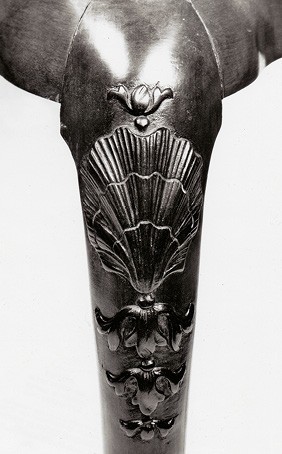
Detail showing the carving on a leg of the tea table illustrated in fig. 33.

Tea table with carving attributed to the shop of Brian Wilkinson, Philadelphia, 1745–1755. H. 29", Diam. of top: 30" (Private collection; photo, Joseph P. Gromacki.)

Detail of the carving on a leg of the tea table illustrated in fig. 36.

Tea table, with carving attributed to the shop of Brian Wilkinson,Philadelphia, 1745–1755. Mahogany with white cedar. H. 27 1/2", W. 34 5/8", D. 21 1/8". (Courtesy, Winterthur Museum.)

Detail showing the carving on a long rail and leg of the tea table illustrated in fig. 38.

Pier table, England, c., 1740. H. 31 13/16", W. 35 5/8", D. 24 1/2". Mahogany with mahogany veneer and larch. (Courtesy, Drayton Hall.)

Desk-and‑bookcase, London, c. 1735. H. 93 3/4", W. 51 1/8", D. 23 5/8". Oak and rosewood with unidentified conifer. (Courtesy, Mackinnon Fine Furniture.

Pier table with carving attributed to the shop of Brian Wilkinson, Philadelphia, c. 1750. Mahogany with yellow pine and white cedar; clouded limestone. H. 31", W. 42", D. 24 5/8". (Private collection; photo, Levy Gallery.)

Detail of the carving on the front rail of the pier table illustrated in fig. 42

Detail of the carving on the front rail and a leg of the pier table illustrated in fig. 42.

Top of the pier table illustrated in fig. 42.

Details showing holes for and remnants of the indexing pins of the pier table illustrated in fig. 42.

Detail showing the back edge of the top of the pier table illustrated in fig. 42

Chest-on-chest attributed to George Claypoole Sr. or Jr. with carving attributed to the shop of Brian Wilkinson, Philadelphia, c. 1750. Mahogany with tulip poplar, and white cedar. H. 85 1/2", W. 43 1/2", D. 22 3/4". (Private collection; photo, Sotheby’s.)

Detail showing the carving on the upper center drawer of the chest-on-chest illustrated in fig. 48.

Desk-and-bookcase with carving attributed to the shop of Brian Wilkinson, Philadelphia, c. 1750. Mahogany with unrecorded secondary woods. H. 84", W. 42", D. 25". (Private collection; photo, Morphy’s.)

Detail of the applique on the desk-and-bookcase illustrated in fig. 50.

Chimney back, Oxford Furnace, Warren County, New Jersey, 1746. Cast iron. 34 1/4" x 34". (Private collection; photo, Vine Cassaro.)

Detail of the chimney back illustrated in fig. 52.
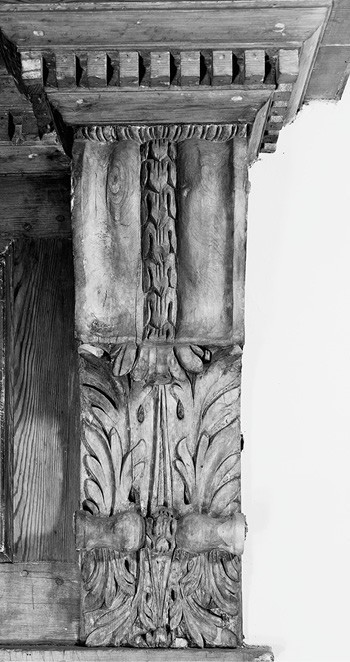
Frontal view of an upper truss on one of the architraves in the stair tower of the Pennsylvania State House. (Courtesy, Historic American Buildings Survey, Library of Congress; photo, Jack E. Boucher, 1959).

Samuel Harding bill to George Claypoole Sr. or Jr. for carving done between May 19, 1755 and February 22, 1757. (Courtesy, Marion Carson Papers, Library of Congress; photo, Don Fennimore.)

Desk-and-bookcase with carving attributed to the shop of Samuel Harding, Philadelphia, c. 1755. Walnut with tulip poplar, yellow pine, and white cedar. H. 100", W. 40 3/4", D. 23 3/4". (Chipstone Foundation; photo, Gavin Ashworth.)

Detail showing the pediment of the desk-and-bookcase illustrated in fig. 56. (Photo, Gavin Ashworth.)
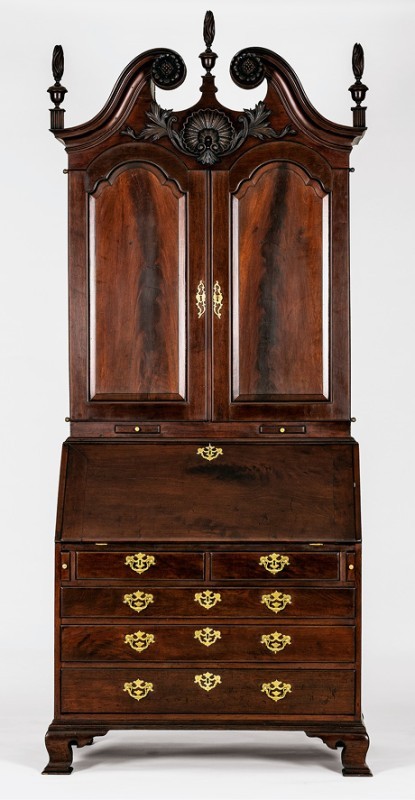
Desk-and-bookcase with carving attributed to the shop of Samuel Harding, Philadelphia, c. 1755. Mahogany with tulip poplar, yellow pine, and white cedar. H. 104", W. 41", D. 24". (Private collection; photo, Robb Quinn.)

Detail showing the pediment of the desk-and-bookcase illustrated in fig. 59.

Desk-and-bookcase with carving attributed to the shop of Samuel Harding, Philadelphia, c. 1755. Mahogany with tulip poplar, yellow pine, and white cedar. H. 105", W. 41 1/8", D. 24 3/4". (Courtesy, Philadelphia Museum of Art; gift of Daniel Blain, Jr.)

Detail showing the pediment of the desk-and-bookcase illustrated in fig. 60.

Tall clock case with movement by John Wood Sr. or Jr. and carving attributed to the shop of Samuel Harding, Philadelphia, c. 1755. Walnut with tulip poplar. H. 107 1/2", W. 23 1/2", D. 11 3/8". (Courtesy, © Metropolitan Museum of Art; bequest of W. Gedney Beatty, 1941.)

Detail showing the pediment of the tall case clock illustrated in fig. 62.

High chest of drawers with carving attributed to the shop of Samuel Harding, Philadelphia, c. 1755. Mahogany with white cedar, tulip poplar, and pine. H. 93", W. 40", D. 20". (Courtesy, James Kilvington Antiques.)

Detail showing the carving on the upper center drawer of the high chest illustrated in fig. 64.
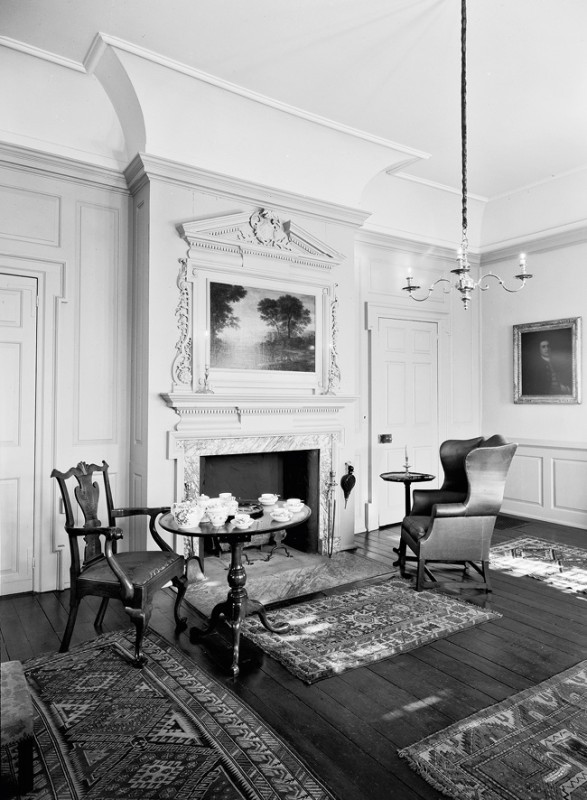
Chimneypiece in Woodford Mansion, Philadelphia, c. 1755. (Courtesy, Historic American Buildings Survey, Library of Congress; photo, Jack E. Boucher.)

Details showing carved linen-fold shells attributed to the shops of Brian Wilkinson (left), fig. 23, and Samuel Harding (right), fig. 56.

Details showing flat shells attributed
to the shops of Brian Wilkinson (left), fig. 50,
and Samuel Harding (right), fig. 60.

Details showing leafage on furniture appliques attributed to the shops of Brian Wilkinson (left), fig. 50, and Samuel Harding (right), fig. 56.

Details showing leafage on architectural appliques attributed to the shops of Brian Wilkinson (top) and Samuel Harding (bottom).

Desk-and-bookcase, Philadelphia, 1735–1745. Mahogany with tulip poplar and yellow pine. H. 89", W. 41 1/8", D. 24". (Private collection.) The shield ornament on this desk-and-bookcase is the earliest Philadelphia example known. Given the probable date of this object, Anthony Wilkinson is a likely candidate for its carver.

High chest of drawers, Philadelphia, 1745–1755. Walnut and walnut veneer with tulip poplar, white cedar, and yellow pine. H. 85 5/8", W. 43", D. 24". (Private collection; photo, Museum of Early Southern Decorative Arts.) The carving on this chest is stylistically related to that from the Wilkinson and Harding shops, but the leafage is crude by comparison.

Dressing table, Philadelphia, c. 1750. Mahogany with white cedar, tulip poplar, and yellow pine. H. 31", W. 33 1/2", D. 21". (Private collection; photo, Gavin Ashworth.) This dressing table is one of the most fully developed examples of its era. As the details shown in figs. 5 and 6 reveal, the leaf carving on the knees is superior to that on the drawers and most closely resembles work associated with the Wilkinson shops.

Detail of the carving on the drawer of the dressing table illustrated in fig. 4. (Photo, Gavin Ashworth.)

Detail of the carving on a leg of the dressing table illustrated in fig. 4. (Photo, Gavin Ashworth.)

Side chair, Philadelphia, c. 1750. Walnut. H. 41 1/2". (Courtesy, Christie’s)

Side chair, Philadelphia, c. 1750. Walnut. H. 42 1/2". (Courtesy, Christie’s)

Detail showing the knee carving on the side chair illustrated in fig. 8.
